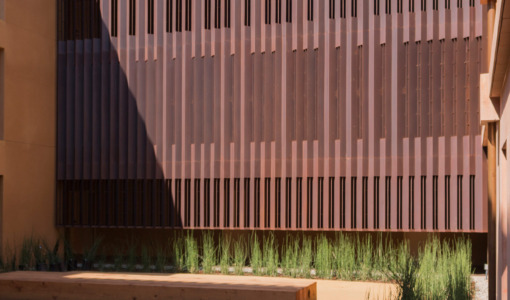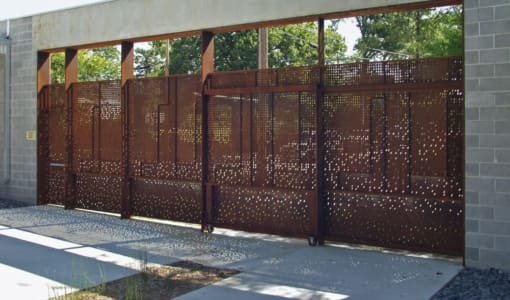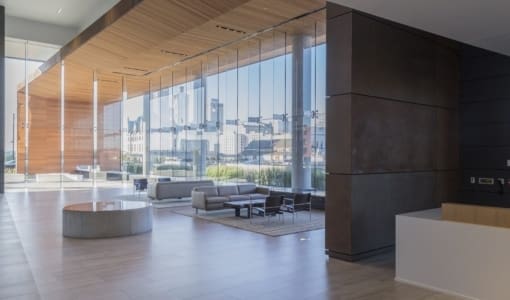Weathering Steel
Architectural Metal for Art & Architecture
Weathering steel is a category of steel metals which contain copper as an alloying constituent. Also known as copper-bearing steel—or by the genericized tradename Corten—these alloys will develop a rust-like oxide layer when exposed to weather. This oxide layer typically takes years to develop. Once developed, the oxide layer protects the metal from further corrosion and rusting. The long-term performance and aesthetics of weathering steel makes it an attractive option for architects and artists. However, there are some caveats to using weathering steel, and these are described in the article below.
Note: Zahner provides high-end engineered metal systems through design assist procurement for applications in art and architecture. To use weathering steel as part of your design, please establish a budget for your project and share your project’s information with the Zahner sales team.
Weathering Steel vs Carbon Steel: Understanding the Oxide Layer
All forms of metal, both ferrous and nonferrous, develop oxide films when exposed to the atmosphere. Oxide development is a natural occurrence by which a metal tends toward its natural density. All metals have this entropy. When exposed to the atmosphere, metals seek to return to a more natural, energy-balanced state.
In most common carbon steels, the oxide develops to the point that total decay may occur, as signaled by the powdering of red rust. The oxide film on most steels is porous and allows moisture and oxygen to continue corroding the surface. Some high-strength steel and copper-bearing steels develop dense adherent oxide films that slow the rate of corrosion. These steels are the “weathering” steels. Similarly to the oxides on copper and aluminum, the density of the oxide layer prevents further corrosion to the surface of the metal.
Weathering Steel Aging: How to Stabilize Corten Metals
When weathering steel sheet is produced at the mill, it has a bluish black color. As moisture, even slight condensation, collects on the surface, streaks of reddish brown rust develop. Further exposure leads to a coarse fine layer of rust eventually covering the entire surface of the metal.
If installed in this raw state, the runoff of the rust film will quickly stain adjacent materials such as concrete wainscots and sidewalks below the weathering steel installation. Designing with this material requires special attention to runoff and moisture control.
The rust film on a metal surface is very adherent. The impervious iron oxide film will work to resist further corrosion of the base metal. Eventually, the runoff slows down to a point where further staining is minimal.
History: The Rise, Fall, and Resurgence of Weathering Steel
In the 1960s and 1970s, weathering steel came into its own. Cor-Ten, originally developed for railcar, began to see wide use as an architectural metal. One of the first major examples of weathering steel used in an architectural sheathing context is the John Deere Headquarters. Designed by Eero Saarinen, the facade used Cor-Ten weathering steel. Saarinen had noticed the interesting dark brown steel surfaces on railway cars used to transport grain. An unfinished weathering steel was used for grain cars because of the abrasive nature of the grain kernels on painted steel cars.
John Deere Headquarters clad in weathering steel. Designed by Eero Saarinen.
PHOTOGRAPH BY HAROLD CORSINI, COURTESY EERO SAARINEN COLLECTION. SOURCE: GABRIEL JORBY.Over the next decade, many more designers would specify the industrial metal for architectural purposes. However, the designers were specifying the material far too thin for the sustainability of the material. Problems developed when the corrosion of the inside surface of the steel occurred at accelerated rates in comparison with the outer surface.
When sheet metal thicknesses less than 0.032 inches (0.813 mm) were used, areas began to experience premature perforation of the metal. In applications where water was allowed to erode the surface, such as on leaders and scuppers, the protective layer of rust was removed. Corrosion of the surface continued until portions of the metal dissolved completely. For a number of years, weathering steel was discontinued as an architectural metal in sheet form because of premature perforation of the sheet steel.
Today, weathering steel is experiencing a resurgence as a result of correct thickness specification, and modern detailing which allows for proper drainage. In addition, many successful installations of the metal are typified by painting the inner side of the sheet metal with a thick protective paint coating. Most importantly, the thicknesses of the metal used in exterior applications are 16ga or thicker, double the thickness of previous uses.


















 PHOTO ©️ Parrish Ruiz de Velasco (parrch.com)
PHOTO ©️ Parrish Ruiz de Velasco (parrch.com)



 © Fedora Hat Photography
© Fedora Hat Photography Photo by Andre Sigur | ARKO
Photo by Andre Sigur | ARKO





 Ɱ, Creative Commons Attribution-Share Alike 4.0 International license, edited.
Ɱ, Creative Commons Attribution-Share Alike 4.0 International license, edited.

